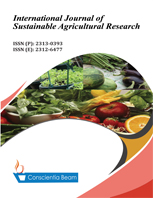Analysis of Rainfall and Temperature Variability to Guide Sorghum (Sorghum Bicolar) Production in Miesso Areas, Eastern Ethiopia
DOI:
https://doi.org/10.18488/journal.70/2015.2.1/70.1.1.11Abstract
Assessment of climate variability at local level has enormous advantage in Ethiopia, where the driver of the economy is agriculture. This study was conducted to analysis rainfall and temperature variability to guide sorghum production in Miesso. Daily climate data was obtained from the National Meteorological Service Agency of Ethiopia (NMA). Temporal rainfall variability was assessed through the timing of onset date, end date, length of growing season and dry spell length using INSTAT climate guide. Temperature variability was examined in terms of pattern, trend and probability of exceedence. The long-term annual rainfall showed high variability from year to year with 25% coefficient of variation. Seasonally, the MAM total rainfall showed high variability than the JJAS total rainfall at Miesso. Rainfall onset date and length of growing season were highly variable. Higher minimum temperature values (>16 oC) are observed from April to August whereas maximum temperature reaches its lowest level in December, but increase again to maximum in June and start to decline as of July. The minimum and maximum temperatures showed an increasing trend both seasonally and annually. To avert the risks of rainfall and temperature variability the use of seasonal climate outlook is recommended for adjusting farm operations and farming system decisions in Miesso areas.

